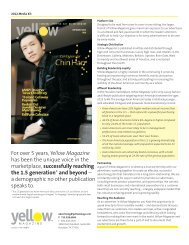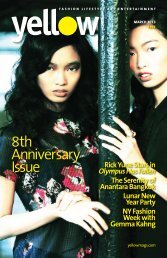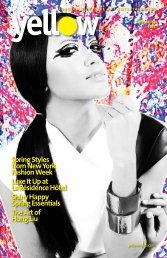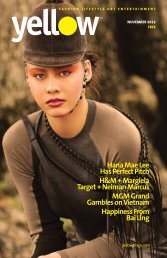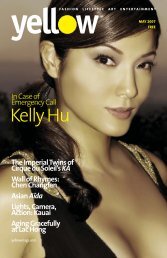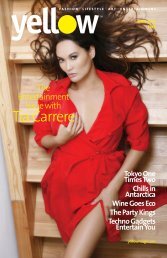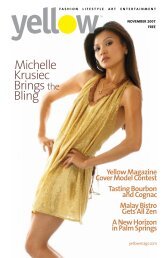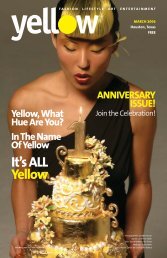Creativity in the Bag with Mari Omori Pavan ... - Yellow Magazine
Creativity in the Bag with Mari Omori Pavan ... - Yellow Magazine
Creativity in the Bag with Mari Omori Pavan ... - Yellow Magazine
Create successful ePaper yourself
Turn your PDF publications into a flip-book with our unique Google optimized e-Paper software.
ART & CULTURE<br />
Artist <strong>Mari</strong> <strong>Omori</strong><br />
Tea is Her <strong>Bag</strong><br />
<strong>Mari</strong> <strong>Omori</strong><br />
16 | September 2006<br />
by FRANCES TROTTER<br />
The “Crossroads: Asia/America” exhibition will open on September 30, 2006, at <strong>the</strong> Galveston Arts Center. It will primarily focus upon Asian American<br />
artists resid<strong>in</strong>g <strong>in</strong> Texas. One of <strong>the</strong> prom<strong>in</strong>ent artists be<strong>in</strong>g featured is Japanese born, <strong>Mari</strong> <strong>Omori</strong>, who has shown widely <strong>in</strong> Texas and California.<br />
Tra<strong>in</strong>ed as a pa<strong>in</strong>ter at UCLA, <strong>Mari</strong>’s work currently focuses on <strong>in</strong>stallation. Gauzy and monochromatic, her filmy sculptures and forms represent deep,<br />
spiritual, and conceptual memories and processes. The delicate manner by which <strong>the</strong>y are constructed will <strong>in</strong>trigue you.<br />
Portrait by Diana Sorensen<br />
<strong>Mari</strong>’s large-scale <strong>in</strong>stallations are comprised of tea bags, str<strong>in</strong>g, wax, and<br />
o<strong>the</strong>r materials, often sewn toge<strong>the</strong>r and o<strong>the</strong>rwise compiled. Tea bags,<br />
as well as <strong>the</strong> Tea Ceremonies, play a significant <strong>in</strong>fluence upon <strong>the</strong> artist,<br />
as she arranges thousands of teabags <strong>in</strong>to a s<strong>in</strong>gle sculpture. S<strong>in</strong>ce 1997,<br />
<strong>Mari</strong> has been collect<strong>in</strong>g hundreds of used teabags to construct objects.<br />
Her work draws upon tea sta<strong>in</strong>s to express spirituality and life.<br />
At once subtle and startl<strong>in</strong>g, observers may not be aware that <strong>the</strong> drap<strong>in</strong>g<br />
softness of her <strong>in</strong>stallations is constructed from thousands of teabags.<br />
Steeped <strong>in</strong> natural pigments <strong>the</strong>se cloth-like sculptures reflect <strong>Mari</strong>’s<br />
mysterious creativity.<br />
How would you describe <strong>the</strong> difference between your pa<strong>in</strong>t<strong>in</strong>gs and<br />
your <strong>in</strong>stallations?<br />
I have a Master of F<strong>in</strong>e Arts degree from UCLA <strong>in</strong> Pa<strong>in</strong>t<strong>in</strong>g and Draw<strong>in</strong>g.<br />
In a way, I came to art by way of pa<strong>in</strong>t<strong>in</strong>g. However, I have always been<br />
<strong>in</strong>terested <strong>in</strong> space; <strong>the</strong> space <strong>with</strong><strong>in</strong> pa<strong>in</strong>t<strong>in</strong>gs, <strong>the</strong> space def<strong>in</strong>ed by<br />
objects, <strong>the</strong> space experienced by <strong>in</strong>stallations etc. I chose media for its<br />
expressions. Currently, I am <strong>in</strong> <strong>the</strong> process of organiz<strong>in</strong>g a group show of<br />
Asian/American artists at <strong>the</strong> Galveston Arts Center for a September 30th<br />
open<strong>in</strong>g. Crossroads: Asia/America will be an eye-open<strong>in</strong>g, ever-<strong>in</strong>spir<strong>in</strong>g<br />
exhibition of diverse, multi-media artists <strong>in</strong> south Texas.<br />
In my work, I use tea as a start<strong>in</strong>g po<strong>in</strong>t of<br />
a journey to come toge<strong>the</strong>r <strong>with</strong> mutual<br />
respect and understand<strong>in</strong>g <strong>with</strong> my guests.<br />
As a sculptor, I let <strong>the</strong> forms evolve<br />
<strong>with</strong><strong>in</strong> <strong>the</strong> material.<br />
Mat<strong>the</strong>w Barney’s recent film <strong>with</strong> Bjork, Draw<strong>in</strong>g Restra<strong>in</strong>t, takes place<br />
on a Japanese whal<strong>in</strong>g ship. In one of <strong>the</strong> most crucial scenes, <strong>the</strong> lovers<br />
share a tea ceremony <strong>with</strong> <strong>the</strong>ir host. You have remarked that <strong>the</strong> tea<br />
ceremony is highly regarded <strong>in</strong> many cultures, especially <strong>in</strong> connection<br />
<strong>with</strong> visitors and guests. In what way does <strong>the</strong> idea of tea <strong>in</strong>fluence <strong>the</strong><br />
concept you have of be<strong>in</strong>g a sculptor?<br />
The way of tea is more than etiquette. Serv<strong>in</strong>g tea and receiv<strong>in</strong>g it is<br />
cultural syn<strong>the</strong>sis brought toge<strong>the</strong>r <strong>with</strong> profound aspects of religion,<br />
aes<strong>the</strong>tics, philosophy, morality, discipl<strong>in</strong>e, etc. It is a moment of spiritual<br />
and mental unity, all encompass<strong>in</strong>g our existence. In my work, I use tea<br />
as a start<strong>in</strong>g po<strong>in</strong>t of a journey to come toge<strong>the</strong>r <strong>with</strong> mutual respect and<br />
understand<strong>in</strong>g <strong>with</strong> my guests. As a sculptor, I let <strong>the</strong> forms evolve <strong>with</strong><strong>in</strong><br />
<strong>the</strong> material.<br />
Location and environment seem to exert a strong impact upon your<br />
identity as an artist. As a Japanese woman resid<strong>in</strong>g <strong>in</strong> America, do you<br />
feel that you are accepted?<br />
My formative years were spent <strong>in</strong> sou<strong>the</strong>rn California where Japanese<br />
and o<strong>the</strong>r Asian communities were larger than <strong>in</strong> <strong>the</strong> sou<strong>the</strong>rn part of<br />
<strong>the</strong> U.S. However, I have been <strong>in</strong>spired by <strong>the</strong> nature and <strong>the</strong> culture of<br />
south Texas and I have felt at home here s<strong>in</strong>ce 1992. There is no question<br />
that I am accepted.<br />
How does <strong>the</strong> idea of community or “collective culture” <strong>in</strong>fluence<br />
your work?<br />
The idea of community is central to my work. Perhaps this is derived from<br />
my profession as an art <strong>in</strong>structor for more than 20 years. I have been<br />
fasc<strong>in</strong>ated by <strong>the</strong> uniqueness of <strong>in</strong>dividuals, as well as <strong>the</strong> power of<br />
community efforts. I am <strong>in</strong>terested <strong>in</strong> work<strong>in</strong>g around <strong>the</strong> ideas of<br />
s<strong>in</strong>gularity and multiplicity.<br />
Your work is often delicate and gauzy, but your pa<strong>in</strong>t<strong>in</strong>gs seem to reference<br />
stronger <strong>the</strong>mes, although seem<strong>in</strong>gly whimsical, such as atomic warfare<br />
as illustrated by 60th Hiroshima and Listen<strong>in</strong>g. What is beh<strong>in</strong>d this?<br />
The pieces you have mentioned were created last summer <strong>in</strong> <strong>the</strong> Encaustic<br />
workshop <strong>in</strong> K<strong>in</strong>gston, New York. Prior to that trip, I was visit<strong>in</strong>g Hiroshima<br />
dur<strong>in</strong>g <strong>the</strong> 60th anniversary of its bomb<strong>in</strong>g. I wanted to create <strong>in</strong>timate<br />
scale encaustic pa<strong>in</strong>t<strong>in</strong>gs that reflected my experience of that particular<br />
time and memory.<br />
The Japanese culture is very polite and has <strong>in</strong>fluenced Western art, music,<br />
literature, animation, and customs. How has <strong>the</strong> American culture affected<br />
you, ei<strong>the</strong>r positively or negatively, s<strong>in</strong>ce you moved here?<br />
My residency <strong>in</strong> <strong>the</strong> U.S. has been long, yet it has become <strong>in</strong>creas<strong>in</strong>gly<br />
mean<strong>in</strong>gful. I came to this country as a quiet, shy person who did not<br />
exactly know what were my possibilities. This may sound cheesy but,<br />
lately, I feel a responsibility as an artist, especially as an Asian American<br />
artist, for build<strong>in</strong>g a strong art community <strong>in</strong> Houston.<br />
If you could select any material, medium, time, place, and size of project,<br />
and had no constra<strong>in</strong>ts as to time, money, or energy, what k<strong>in</strong>d of object<br />
would you make?<br />
I envision a large scale soft structure made us<strong>in</strong>g a quilt technique and<br />
constructed by thousand of hands; a multiple collaboration between<br />
artists of diverse media and culture, <strong>in</strong> which all <strong>the</strong> makers could fit<br />
<strong>with</strong><strong>in</strong> <strong>the</strong> structure, like a dwell<strong>in</strong>g place (ha!).<br />
You have said, “Although I am from Japan, I have lived <strong>in</strong> America long<br />
enough that my identity and my notion of home have been obscured...”<br />
Is this a juxtaposition of identity due to displacement and/or<br />
homesickness? Or have o<strong>the</strong>r events <strong>in</strong> your life affected your attitude?<br />
The two words that come to m<strong>in</strong>d are long<strong>in</strong>g and belong<strong>in</strong>g. I long for<br />
my home country and my family <strong>in</strong> Japan. At <strong>the</strong> same time, I s<strong>in</strong>cerely<br />
want to assimilate and belong to <strong>the</strong> community where I live and work.<br />
These two emotions and desires are <strong>in</strong>tertw<strong>in</strong>ed and co-exist harmoniously<br />
<strong>with</strong><strong>in</strong> me.<br />
There seems to be a trend away from <strong>the</strong> Los Angeles-<strong>in</strong>spired<br />
animation/referential work to <strong>the</strong> more subtle conceptual work of<br />
yesteryear. Be<strong>in</strong>g from California, what do you th<strong>in</strong>k about <strong>the</strong> youthful<br />
characterization associated <strong>with</strong> Japanese culture that has become popular<br />
<strong>with</strong> young hipsters? Your work seems to steer clear of that genre<br />
altoge<strong>the</strong>r, preferr<strong>in</strong>g a relatively quiet <strong>in</strong>trospective place, far from <strong>the</strong><br />
world of hyperactive cartoon characters.<br />
It may be someth<strong>in</strong>g to do <strong>with</strong> generation. I am a member of <strong>the</strong> postwar<br />
baby boomer generation. Although I was raised <strong>with</strong> limited material<br />
resources, <strong>the</strong>re was no lack of spiritual or moral resources. Art was always<br />
appreciated <strong>in</strong> my household. Nature was revered. I have witnessed <strong>the</strong><br />
post-war Japan as it has gone through westernization<br />
and <strong>in</strong>dustrialization. It was truly an amaz<strong>in</strong>g life<br />
chang<strong>in</strong>g story through which I have lived. I wish to<br />
convey that experience through my work <strong>with</strong> <strong>the</strong><br />
use of media and/or ideas.<br />
Why does <strong>the</strong> word “Pilgrimage” show up <strong>in</strong> your<br />
work?<br />
Creat<strong>in</strong>g art is very much like a pilgrimage to where<br />
I once was. It does not necessarily imply that I am<br />
return<strong>in</strong>g to a specific place but it is more like a mental<br />
journey that I take dur<strong>in</strong>g <strong>the</strong> process of art mak<strong>in</strong>g.<br />
It is highly focused, yet filled <strong>with</strong> emotion.<br />
Last question. What is your favorite color?<br />
My favorite colors are orange and black; I react to<br />
<strong>the</strong>m immediately. However, when I pa<strong>in</strong>t, my favorite<br />
color is yellow.



